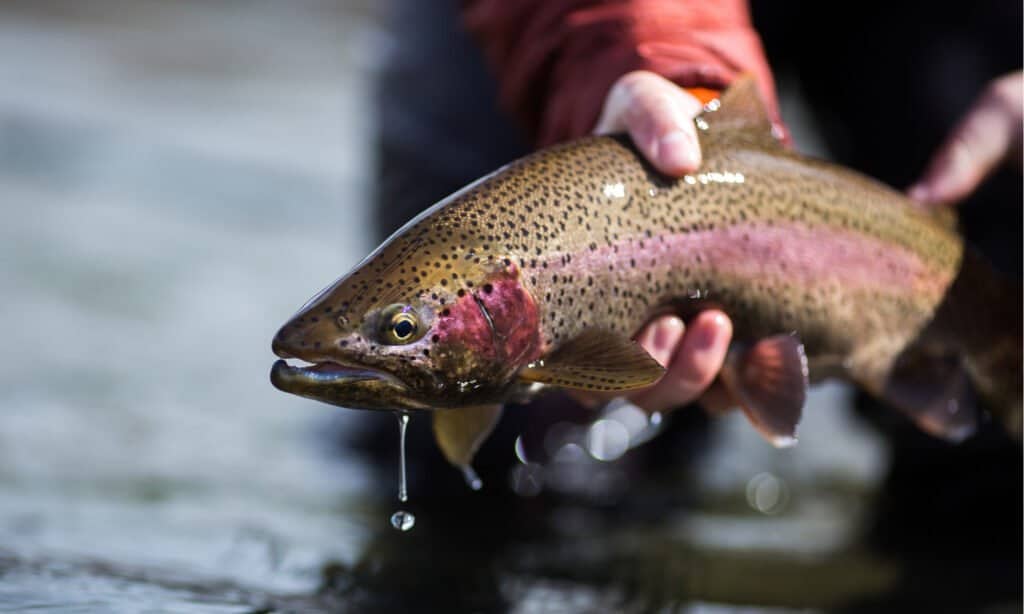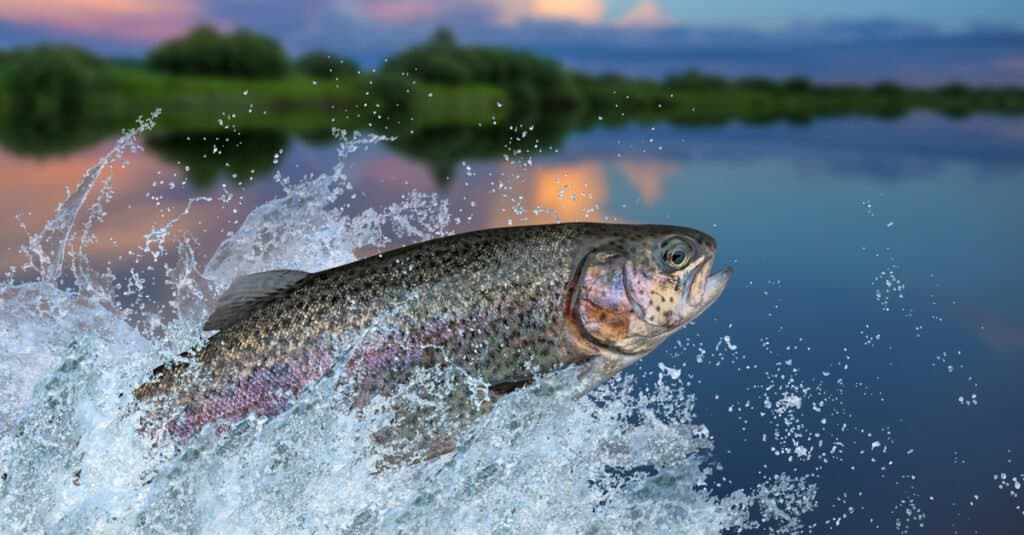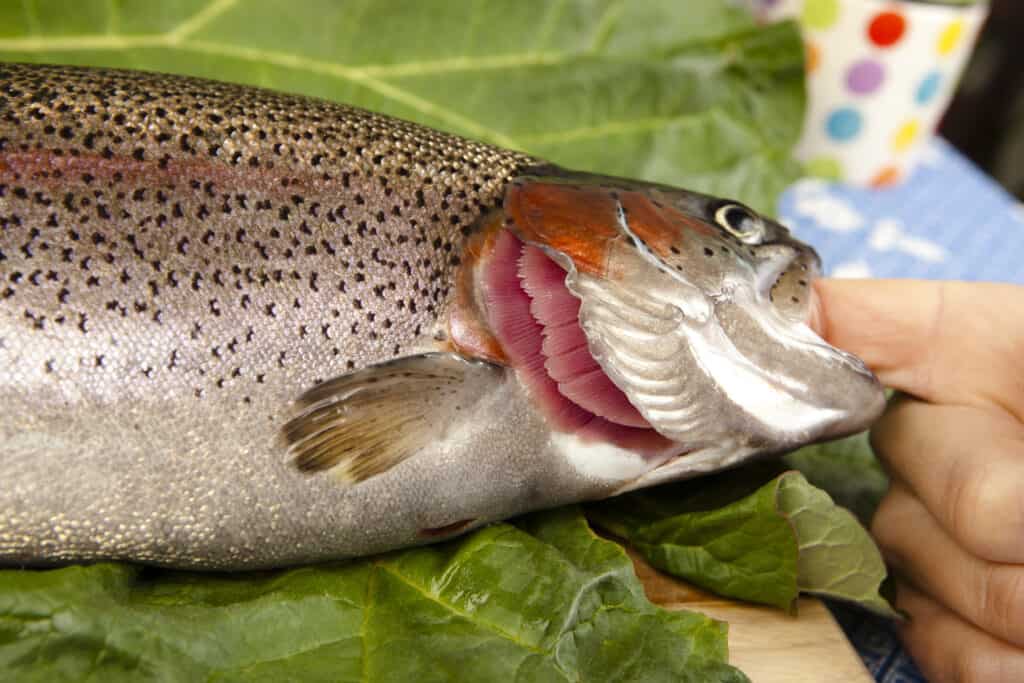Rainbow trout are a species of fish native to the cold waters of the Pacific Ocean in Asia and North American lakes and rivers. Throughout the world, rainbow trout have been introduced to every continent except Antarctica. There are several different names for these fish, such as ‘steelheads’, ‘steelhead trout’, ‘ocean trout’, and even ‘redband trout’. Depending on the species, they can grow anywhere between 7 and 12 inches long. They will also generally weigh about 8 pounds on average. However, one of the largest rainbow trout ever caught weighed 57 pounds, which is a record!
These fish are incredibly popular amongst fishermen. In fact, there are many forums and discussions on the best way to catch these fish!
Do you want to know more about rainbow trout? Let’s learn all about what rainbow trout eat as well as other fascinating facts!
Why Do They Call Them Rainbow Trout?

Rainbow trout got their name from the multi-colors found on their bodies.
©Cannon Colegrove/Shutterstock.com
First, let’s find out how rainbow trout got their name! The rainbow trout and steelhead are ray-finned salmon species and one of the top North American sport fish. Even though steelhead and rainbow trout are the same species, their lifestyles differ significantly. Freshwater is the only habitat that rainbow trout live in for most of their lives. Despite the freshwater’s unpredictable conditions, rainbow trout find protection in aquatic vegetation, boulders, and wood.
The steelhead fish, on the other hand, spend most of their lives in the sea before moving into rivers to reproduce. However, this difference is what is responsible for the rainbow trout’s appearance.
The main reason rainbow trout are named so is because of their brilliant, multi-hued colors that make them so recognizable. In addition to a pink-red stripe that runs from the gills to the tail and black spots on their back, their bodies are typically shades of blue, green, or yellow. However, it is also important to note that a rainbow trout’s appearance can change depending on the waters it lives in.
Now that we know where rainbow trout get their name, let’s see what they eat in order to learn more about them.
What Do Rainbow Trout Eat?

The rainbow trout is not a picky eater and will eat insects, small fish, and even mice!
©FedBul/Shutterstock.com
Rainbow trout eat a diet that consists of insects, minnows, and other small fish. They are classified as carnivores and they do not have a picky appetite at all. This species of animal is actually a predator with a varied diet and will eat nearly anything if they are able to catch it. There have even been instances when they have been known to eat things that are not very good for their health, like trash that has fallen into the streams of rivers.
It is common for rainbow trout, as well as juvenile steelhead in fresh water, to consume aquatic insects such as caddisflies, stoneflies, mayflies, and aquatic Diptera. Additionally, they consume fish eggs and terrestrial insects that fall into the water, including ants, beetles, grasshoppers, and crickets. This predator also preys upon small fish of about one-third of its length of itself, crayfish, shrimp, and other kinds of crustaceans. There have even been reports of hatchling snakes, including barred grass snakes, being eaten by them.
Many fishermen often wonder what the best bait is to catch rainbow trout and the truth is that they will really eat anything! They do, however, prefer live or fresh bait like shad, sardines, anchovies, mackerels, and nightcrawlers.
A Complete List Of The Rainbow Trout Diet
In addition to the fact that rainbow trout are carnivores, we have already discussed how they will eat anything and everything that they are able to fit into their mouths. That means that their diet will be pretty diverse.
The rainbow trout diet consists of the following:
- Insects such as caddisflies, mayflies, stoneflies, midges, crickets, earthworms, leeches, ants, and moths
- Insect larvae
- Snails
- Crustaceans such as shrimp, crayfish, scuds, and sowbugs
- Fish eggs
- Plankton
- Other small fish such as minnows and sardines
- Mice
As far as food sources are concerned, rainbow trout usually make use of whatever they can find. We now know what rainbow trout eat, but what about how they find it? Let’s take a closer look at how rainbow trout find their food.
How Do Rainbow Trout Find Their Food?
It is common for rainbow trout to hold in one spot in moving water, waiting for the water current to bring food directly to them. It is essential for these fish to have access to aquatic insects that are adrift in the current as their primary source of food. The rainbow trout in moving waters are also searching for refuge from the current in addition to food and protection from predators.
Although rainbow trout feed all day, early morning and late afternoon are their most active feeding times. However, rainbow trout have also been known to feed at night. They also especially like to feed during a rainstorm. There is a reason for this, as insects on the banks get washed into the water and become the primary source of food for the rainbow trout.
What Animals Prey On Rainbow Trout?
Rainbow trout happen to be an incredibly important source of food for many animals. This even includes humans! Many piscivorous (fish-eating) fishes, including sculpins, smallmouth bass, and larger trout, consume young rainbow trout. There are also many wildlife species that rely on rainbow trout for food as well.
The list includes birds such as herons and kingfishers, as well as mammals such as American black bears, river otters, raccoons, and even humans such as ourselves. Among the many fish that anglers try to catch, rainbow trout are often among the favorite catches.
Aside from being one of the top five game fishes found in North America, hatchery fish are also easy to catch, which makes them a great choice when fishing. Would you like to know whether rainbow trout is a healthy fish to eat or if you should stay away from it? Next, we’ll discuss the health benefits of eating rainbow trout and what it tastes like.
Is Rainbow Trout Healthy To Eat?

Rainbow trout is an incredibly healthy fish to eat complete with vitamins and omega fatty acids.
©pfluegler-photo/Shutterstock.com
The rainbow trout is one of the most common fish found in grocery stores. However, is rainbow trout actually a healthy fish to eat, or is it something that should be avoided? The answer is that yes, rainbow trout is an excellent fish to incorporate into your diet! There are many nutritional benefits associated with trout, including protein, niacin, vitamin B12, and omega-3 fatty acids.
Our bodies are constructed from proteins. Protein plays an important role in growth and development, and it aids in the repair of damaged tissues. The function of niacin in the body is to provide energy from food. Niacin also aids in digestion, skin, and nerve function. The formation of red blood cells, which carry oxygen throughout the body, is heavily dependent on vitamin B12. Lastly, Omega 3 fatty acids are important for brain function by helping with memory, performance, and behavior, as well as supporting normal growth and development. Additionally, omega-3 fatty acids reduce inflammation and may reduce your risk of chronic diseases like arthritis, heart disease, and cancer.
In general, rainbow trout is extremely beneficial to our bodies. Having said that, you may be wondering what this fish tastes like. There are some similarities between this fish and salmon, but its flavor is much milder and nuttier, with a hint of sweetness. In addition, they don’t have a strong fishy flavor, which makes them ideal for those who are eager to try a new kind of fish and are looking for something new to try.
Up Next:
The photo featured at the top of this post is © FedBul/Shutterstock.com
Thank you for reading! Have some feedback for us? Contact the AZ Animals editorial team.







